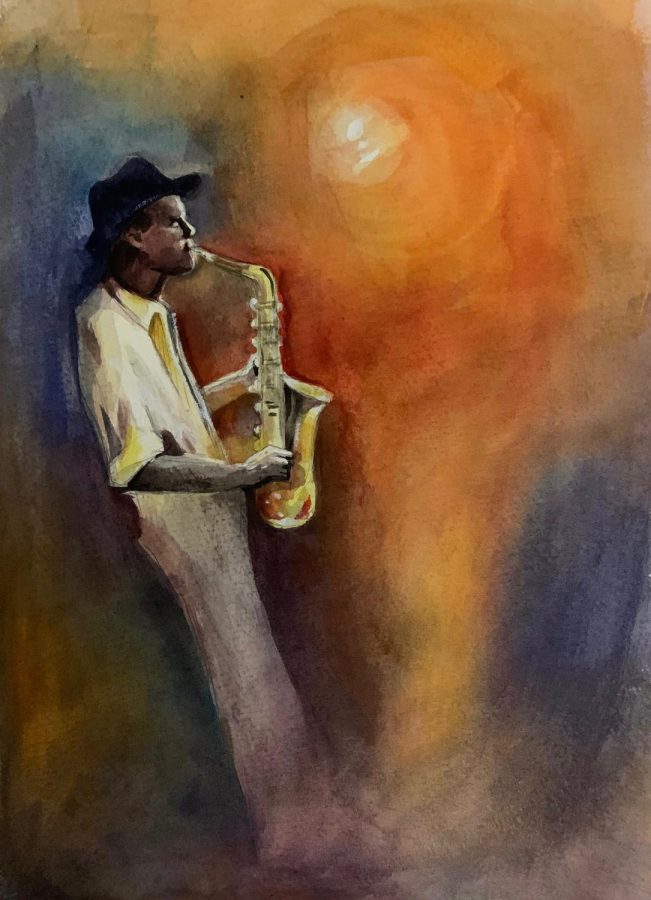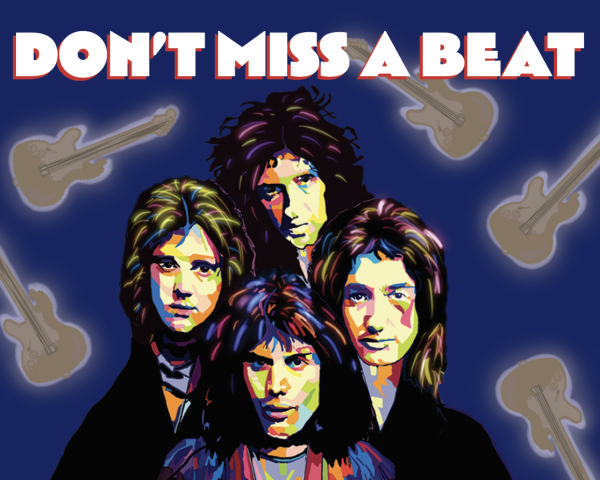The Original Punk Rock
Jazz music’s place in the modern world is one of versatility. While it is widely believed that this art form is dying off, many are unaware of the influence this symbolic genre has had on various common music styles today.
Louis Armstrong, Duke Ellington, Billie Holiday, Benny Goodman, Charlie Parker, Dizzy Gillespie, Miles Davis, John Coltrane, Thelonious Monk and Dave Brubeck. These musicians—among hundreds of others—carry a legacy as some of the greatest jazz music ever recorded, but also represent a period of history that changed the course of modern American culture.
One of the earliest forms of jazz was Dixieland, which developed in New Orleans in the early 20th century. This was the era of classic jazz: Louis Armstrong moved to Chicago and Duke Ellington began playing with his sextet in nightclubs. During the ‘20s to the ‘30s, jazz was truly popular music in America; jazz wasn’t insider’s music like much of it is today. Everyone listened to it, and more importantly, they danced to it.
Right through the 1940s, jazz was the epitome of dance music. Big band and swing jazz came onto the scene in the mid-1930s, bringing crowds of people out onto the dance floor. When Charlie Parker and Dizzy Gillespie hit the scene during the Second World War, they would change the course of jazz music forever.
Bebop jazz gave us some of the greatest jazz musicians of all time. By this time, jazz had moved into smaller, dusty, lowlight clubs where songs had less of a melody and improvisation was quickly gaining popularity. These artists weren’t necessarily playing for a popular audience anymore; instead, they were playing for each other, and jazz evolved into more of an art form. This was a breakaway in jazz music, and even though some people hated it, that didn’t matter to the musicians.
“Jazz is less of a genre and more of a mindset. It’s about breaking the rules, exploring and going where people don’t expect you to go—but beautifully.”
– Matthew Caren
Hardbop came onto the scene in the ‘50s, but by then rock and roll had taken center stage and all the kids ran to Elvis. After that, there weren’t many jazz musicians that caught the eye of the general public.
In the late ‘60s and ‘70s, jazz evolved towards a more experimental direction, becoming less about the music and more about the musician. These days, there is no one that comes close to musicians like Charlie Parker or John Coltrane. Many, however, felt as though the music has stopped evolving.
In the ‘90s, there was a slight resurgence in the form of Acid Jazz, but the music was more R&B. Other artists such as Michael Bublé pay homage to the crooners of the ‘40s and ‘50s; he is popular today because people can sing along to his music. Instrumental music has always struggled regardless of the genre, and that’s not something that will simply change overnight.
Where is jazz today?
Steven Lugerner, a multiinstrumentalist, and Stanford Jazz Workshop co-director is a perfect example of what it means to be a jazz musician in the 21st century. “Musicians in this area are sort of a jack of all trades,” Lugerner said.
In addition to teaching and gigging, Lugerner started his own record label, Slow and Steady Records, that looks to sign predominantly West Coast artists in the jazz and creative music scene in general. “I just didn’t really feel like there were any independent record labels that were sitting, supporting artists like me, and I had a lot of friends who were making really, really awesome music,” Lugerner said. “They would make an album and wouldn’t know what to do with it, so the idea was, ‘okay, we’re all doing really creative stuff, and nobody is putting it out for us, so let’s just start our own thing.’”
Lugerner also teaches seminars and masterclasses to college students about what it means to be a musician today. He admits that many people have a closed mindset in what they believe jazz to be, thinking it has to be a specific style. That’s not what Lugerner teaches his students: “I think a more liberal view of what jazz is, is that jazz can be anything,” Lugerner said. His favorite part of jazz is the improvisation and the rebelliousness that stems from the ability to improvise. “Improvisation is fundamental and wouldn’t be in existence if jazz hadn’t pioneered it first,” Lugerner said. “To me, the best jazz—and the best music—is improvising and using those elements, but doing it in some rebellious way that pushes the music forward.”
Palo Alto High School junior Matthew Caren shares a similar love for music. When Caren listens to or plays music on one of many instruments he has mastered, he follows sounds and ideas that draw him in rather than the style of music itself; this thought process ultimately lured him into the world of jazz. “Jazz is less of a genre and more of a mindset. It’s about breaking the rules, exploring and going where people don’t expect you to go—but beautifully,” Caren said. “I think you can take that mindset and transplant it into almost any kind of music.”
Caren also shares Lugerner’s view on improvisation and the beauty that is in the imperfections of complete freedom. “Improvisation, a cornerstone of jazz, is such a fascinating and fun and beautiful thing. In some sense, it’s a more pure and direct way of expressing yourself; you convert ideas and emotions directly into music,” Caren said. “It’s like speaking: just as you don’t plan out exactly what words you’re going to say before every conversation, you don’t plan out what notes you’re going to play before you actually start playing. This combination—of freedom, creativity and self-expression—is what I love about jazz.”
After discovering jazz music in middle school, Nathan Palmer, now a freshman at Sacred Heart Prep, became instantly hooked. He plays the alto and tenor saxophone. “Jazz is the most important outlet of self-expression I have in my life and will probably always be the most important,” Palmer said. “Jazz is also a community of people, who, by bringing their particular roles, experiences, and personalities into the music, build on each other to create something new. That is why I love the music and continue to practice; so that when the music speaks to me, I can speak back.”
Palo Alto High School sophomore Owen Rice plays drums and bass guitar, but he also has a soft spot for the story behind jazz as well as the inspiration and sounds he can take from the music. “I feel that in terms of commonality, jazz has been heard less and less, whereas years ago, jazz was the ‘pop’ of today,” Rice said. “Over time, music is expected to change, and I feel that jazz is still present in various amounts of music whether the composer knows it or not. It’s a key backbone to all music.”
“That is why I love the music and continue to practice; so that when the music speaks to me, I can speak back.”
– Nathan Palmer
While jazz musicians indisputably love the genre, outsiders view jazz as a dying music that is not as popular as it once was all those years ago.
Many also have a deep and profound connection to jazz, but some are unaware of the history behind it and its potential to grow and change with the modern world. Lugerner and his colleagues have made it their goal to change that. “I think that there are a lot of musicians who are ‘jazz musicians’ who have been trained in the conservatory, like me,” Lugerner said. “But we’re trying to breathe some youthful, young, sort of contemporary energy into the music, and I think there are a lot of people making really cool, forward-thinking, creative music that has that improvisational and rebellious feeling.”
On the other hand, there are many preconceived notions about what jazz is and who it’s for. Today, a different community is invested in jazz music, and compared to the 1940s and ‘50s, there isn’t as much of a “hip” jazz scene. “More and more, jazz is becoming like classical music where it’s a little too institutionalized,” Lugerner said. “It’s gotten too far into academia and too far away from the streets.”
Palmer does not believe that jazz is a dying genre, and he is excited about its ongoing evolution and the implementation into conservatories. “I think [jazz] is evolving to modern times, with technology and other genres coming out, but it’s not dying,” Palmer said. “An example of its evolution is the idea of studying jazz at a conservatory which brings a competitiveness to the music can hurt it but can also bring opportunities for people from all walks of life to learn jazz without having to necessarily grow up around it.”
Like Lugerner, Caren emphasizes the need for jazz musicians to evolve and change with the modern interpretation of jazz music as well. “Jazz has always been about change and exploration and breaking the rules, and I think that mindset lives on as strong as ever,” Caren said. “You have artists like Jacob Collier, who was featured on three songs on the latest Coldplay album, and Thundercat, who more or less wrote all the songs on Kendrick Lamar’s To Pimp a Butterfly—jazz is alive and well, and in the mainstream too, even if you don’t always notice it. Just because it isn’t some guys wearing fedoras in a smoky jazz club anymore doesn’t mean it’s not still alive. It’s just changing, as it always has, and as it always should.”
Looking to the future, Lugerner hopes for others to begin to share his love for jazz and believes that the first step of doing so is unrelated to the music form itself. “I don’t think there’s a way to revive jazz, and I think if anything, what needs reviving is the audience,” Lugerner said. “Why is it super young kids who are learning about jazz, and really old people, and nobody in between? Unfortunately, I think jazz music hasn’t done a good job of retaining that bigger, modern audience.”
Lugerner hopes that by helping educate young people about jazz and, more specifically, the history of jazz culture, they can learn to connect to the music. “It’s important to realize that like jazz music was mostly pioneered by African American musicians, and it’s the music of its music of improvisation, rebelliousness, but most importantly, it’s the music of oppression,” Lugerner said. “Rebelliousness comes out of feeling disenfranchised with the world and in my opinion, African-American people have felt that more in this country than any other demographic.”
By taking a new perspective on jazz music, and on the message embedded in the music, there is a lot more that can be uncovered. “[Jazz] comes from a place of darkness, but there’s a lot of beauty in that darkness,” Lugerner said. “The more you dig into the history of music, the more you dig into the lives of these people who actually pioneered it, you can see Miles Davis and Charlie Parker and John Coltrane: they are revered as gods, but when they were alive and making music, their life wasn’t that glamorous—they were all struggling, and we don’t really talk about that.”
So while jazz music may no longer be under the popular spotlight, its influence on culture and musical genres all around us has left such a lasting mark in our history that the “death” of jazz is simply not conceivable. Jazz music is ever-changing and ever-growing within the modern world, and jazz musicians are going to continue pushing the boundaries of music. We think we know what is meant by jazz, but time and again we are astonished by jazz’s ability to go beyond our conception.

2019-2020 - Staff Writer
2020-2021 - Editor-in-Chief
I joined C Mag because it felt to me as though the magazine went beyond the borders of the...







